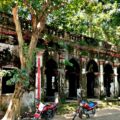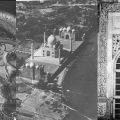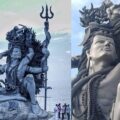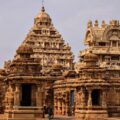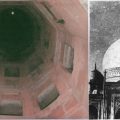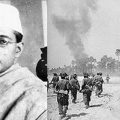Medieval Era Gangatia Estate and Shiva Temple in Bangladesh
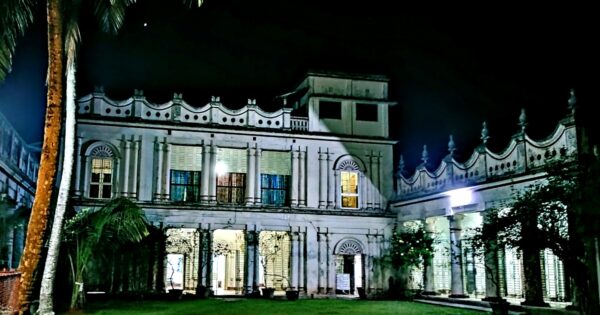
The 400-year-old Gangatia Zamindar house is locally called Manbababur Bari. It is located at village Gangatia of Gobindpur Union at Hossainpur Upazila and about 12 km away from Kishoreganj district headquarters in Bangladesh. This beautifully crafted house is a wonderful example of an ancient civilization. The architectural style of this house shows great use of 18th century Romano-Greek architecture.
Nonagenarian Manibandra Nath Chakraborty Chowdhury, locally known as Manob Babu, the last descendant of the zamindar of Gangatia, lives there. He studied at Kolkata and was elected as Upazilla Chairman in 1983 during the regime of Gen. Earshad. He cultivates fish near his house and his other vast area of his landlord estate.
Manobandra Babu said that a classical scholar from Uttar Pradesh of India came and settled in the East Bengal (presently Bangladesh) in the 16th century AD. His maternal uncle’s home is Komolpur Area of Komolpur subdivision in Tripura State of India. His ancestors belonged to the Brahmin varna from a royal family. He built a Shiva temple for worship – the first temple built by this dynasty.
The zamindar family once gained wide recognition and prestige in the region through religious meditation, worship and rituals.
Dinanath Chakraborty of this clan was the first (landlord) zamindar of the region. At the end of the 18th century, he purchased one-third of the Hossainshahi Pargana and established a landlorship (zamindari) in the region.
Later Dinanath Chakraborty’s son Atul Chandra Chakraborty purchased two more anna-parts from Gnanada Sundari Chaudhurani, the landlord of Athar bari (house), and included them in the Gangatia zamindari. And this is how this zamindar house expanded.
The first Shiva temple of this family built about one kilometer away from the zamindarbari is now dilapidated but it still stands as a witness of time. Near this temple is a huge kund (tank/pond) called ‘Sagardighi’. Next to it is another dilapidated Shiva temple. Family worships are still held there.
Next is a huge gate called Sridhar Bhavan. About 300 yards away from here is the main building of the Gangatia Zamindarbari. From the front of the main gate, one has to cross the beautiful road, about 12 feet wide and lined with coconut trees on both sides, to the zamindarbari. The beauty of this house impresses anyone.
It is really surprising that the architectural style of the house was built so beautifully so long ago. The main building is two storied that includes sitting room, guest room, court room and rooms used for practice of music. There are also chamber (Kacharighar), Nahabatkhana, court house (Durbargriha).
The beautiful craftsmanship on the pillars of this zamindar house is impressive. There is a large courtyard in front of the zamindar house, surrounded by high walls on all four sides.
In the liberation war of 1971, The Pakistani invasion forces and their local collaborators killed his father named Sree Bhupoti Nath Chakraborty Chowdhury. They caused extensive damage to the zamindar house on May-7,1971. A memorial has been built at the place where his father was killed by the Pak Army.
The installation is constantly visited by locals and foreign tourists, teachers-students, journalists and other classes of people. If the zamindar can renovate the house, it can also be one of the attractions.
Currently he is living here lonely. His late younger brother Tapan Kumar Chakraborty Chowdhury and he don’t have any children.
The facade of the Gangatia Zamindar house has Roman architectural columns. From the front, the architectural style of this zamindar house is in one word – extraordinary. This small zamindar house is situated on a large plot of land, spread across 10 acres. The front door of the zamindar house is ornamented with designs.
This zamindar house of craftsmanship and aesthetic beauty still stands in grandeur as a witness to its glorious past.
Disclaimer: The facts and views expressed here are solely of the author. My India My Glory does not assume any responsibility for the validity or information or images shared in this article by the author.
Facebook Comments Box
The following two tabs change content below.


Sangram Datta
Sangram Datta is a history enthusiast from Bangladesh.
Latest posts by Sangram Datta (see all)
- The Six Shakti Peeths of Bangladesh: An Account - July 27, 2024
- Jessoreswari Kali: Shaktipeeth at Satkhira District in Bangladesh - July 27, 2024
- Kachari House of Tripura Monarch at Srimangal in Bangladesh - July 27, 2024

